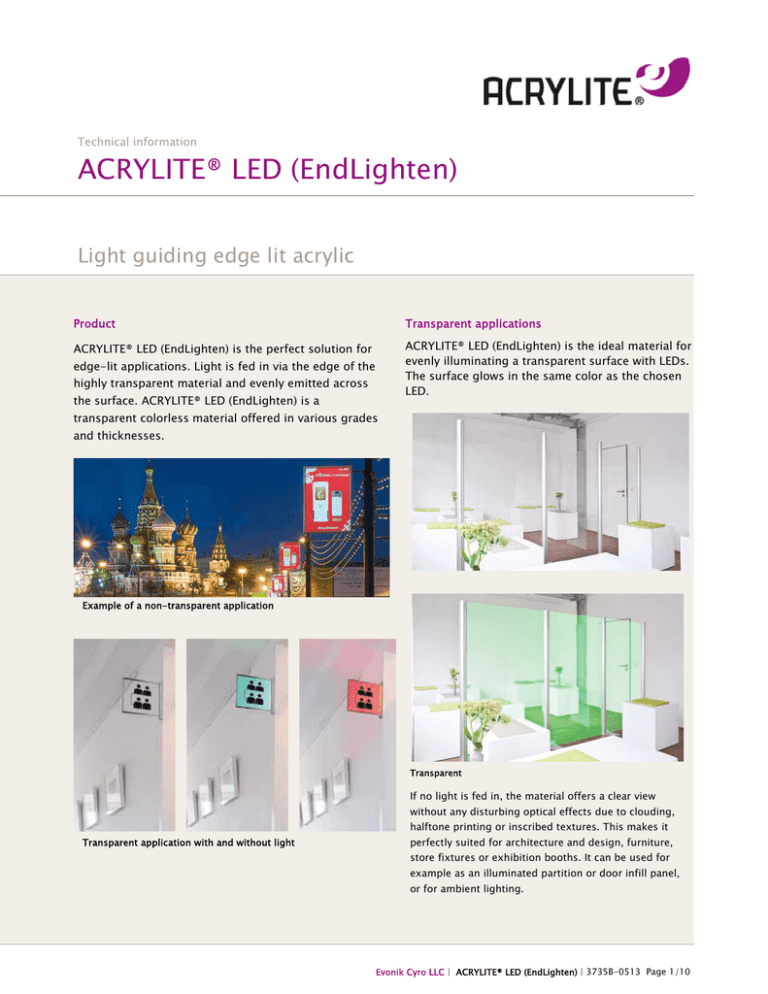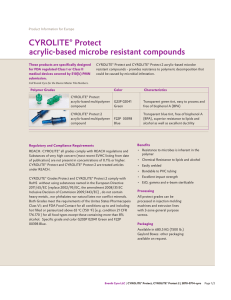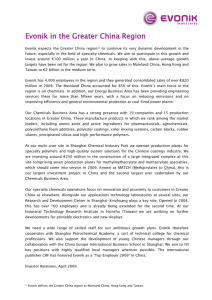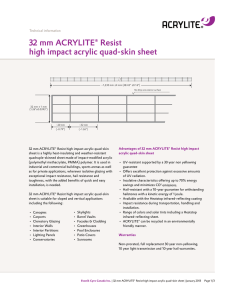
Technical information
ACRYLITE® LED (EndLighten)
Light guiding edge lit acrylic
Product
Transparent applications
ACRYLITE® LED (EndLighten) is the perfect solution for
ACRYLITE® LED (EndLighten) is the ideal material for
evenly illuminating a transparent surface with LEDs.
The surface glows in the same color as the chosen
LED.
edge-lit applications. Light is fed in via the edge of the
highly transparent material and evenly emitted across
the surface. ACRYLITE® LED (EndLighten) is a
transparent colorless material offered in various grades
and thicknesses.
Example of a non-transparent application
Transparent
If no light is fed in, the material offers a clear view
without any disturbing optical effects due to clouding,
halftone printing or inscribed textures. This makes it
Transparent application with and without light
perfectly suited for architecture and design, furniture,
store fixtures or exhibition booths. It can be used for
example as an illuminated partition or door infill panel,
or for ambient lighting.
Evonik Cyro LLC | ACRYLITE® LED (EndLighten) | 3735B-0513 Page 1/10
Non-transparent applications
Mode of operation
(EndLighten) is the ideal material for very slim,
Operating principle
In non-transparent applications, ACRYLITE® LED
large-scale luminous displays and picture frames,
The clear light-diffusing particles embedded in the
luminous ceilings and walls, city light posters and
PMMA deflect the light rays entering the sheet edge.
many other uses. In the application shown here
Total internal reflection in the light guide is
(counter), light is fed in via the edge of the
ACRYLITE® LED (EndLighten) sheet. ACRYLITE®
suppressed, allowing light rays to exit the sheet via
Reflections (Radiant) is used as the patterned sheet.
the surfaces in a controlled manner. This effect
provides a uniformly glowing surface.
ACRYLITE® Clear
Clear ACRYLITE® conducts light by means of total
internal reflection. Light rays remain inside the
sheet only exit via the edges.
ACRYLITE® LED
(EndLighten)
The diffuser particles embedded in ACRYLITE®
LED (EndLighten) deflect light rays and suppress
total internal reflection. Light rays can exit the
sheet via the surfaces too.
In this non-transparent application, light is fed in
via the edge of the ACRYLITE® LED (EndLighten)
sheet and emitted across the surface. ACRYLITE®
Satinice is used as the diffuser sheet. The color of
the surface is determined by the color of the LEDs.
Evonik Cyro LLC | ACRYLITE® LED (EndLighten) | 3735B-0513 Page 2/10
Material properties
Area to be illuminated
In order to determine the size of the light guide, it
has proved useful to define the area to be
illuminated. This is:
• the largest distance between several light sources
• or, if only one light source is used, the distance
between the light source and the opposite unlit
edge
0E010 SM
0E011 L
0E012 XL
0E013 XXL
Evonik Cyro LLC | ACRYLITE® LED (EndLighten) | 3735B-0513 Page 3/10
Efficiency *
Luminance
Depending on the size of the light guide, various
grades of ACRYLITE® LED (EndLighten) are offered.
The diagram on the right shows the average
luminance values*.
Grades SM and L provide higher luminance than
grades XL or XXL, since the same amount of light
that is fed in at the edge is distributed across a
smaller surface.
In order to achieve optimal and uniform luminous
efficiency, it is very important to use the
recommended grade of ACRYLITE®LED (EndLighten)
Uniformity L _min/L _max *
(SM to XXL).
Efficiency and uniformity
Efficiency describes how much input light is emitted
across the surface.
Uniformity refers to even illumination of the sheet,
i.e. the relationship between minimal and maximal
luminance.
The diagrams show the values measured at the
recommended maximum lengths of the respective
Average luminance of ACRYLITE® LED (EndLighten)
grades *
grades. Measurements show that uniformity and
efficiency move in opposite directions, and the
grades were optimized correspondingly. Since the
human eye perceives brightness logarithmically, it
cannot recognize differences less than about 30%.
* the graphs in the diagrams above are based on values
measured with a one-sided light input of about 1,734 lm/m.
* with lighting on both sides (light input on one side: 1,734
lm/m), using a reflector and a white poster
Evonik Cyro LLC | ACRYLITE® LED (EndLighten) | 3735B-0513 Page 4/10
Forming ACRYLITE® LED (EndLighten)
Free forming
e.g. curved (see figure below). The lighting
fabricated. Consideration should be given, however,
Both rectangular and round displays can be
ACRYLITE® LED (EndLighten) can be thermoformed,
properties remain more or less intact. It should be
to the mechanism used by the light guide to
below the critical value for the given material
uniformly emitted towards the front. This is easy to
closer to the center of the curvature impinge on the
the material does not use any patterns in order to
angle of total internal reflection, due to the curved
light input is therefore irrelevant.
ensured that the radius of curvature r does not fall
conduct and distribute the light so that it is
thickness d. Light rays that are fed into the edge
establish with ACRYLITE® LED (EndLighten) because
surface at an angle that is smaller than the critical
achieve the diffusion effect, and the direction of
The diffuser sheet only has to be cut in the same
surface.
This means the light is not conducted into the sheet
at this point, but involuntarily passes across the
shape as the front display (see page 7 for
recommended materials).
surface to the outside. At this point, the surface
In these cases, it is best to use LED modules as the
shines brightly, whereas this light is missing further
light source. These are mounted on flexible strips
reach the surface via the diffuser particles. This may
possible to simply feed the light into the edge of
from the point of light input and can no longer
result in an unevenly lit surface.
to follow the contour of the sheet. This makes it
the diffuser sheet.
The following formula therefore has to be borne in
mind:
Critical math value: r ≥ 3.2 •d
In practice we recommend a radius of curvature of:
r ≥ 6x material thickness
Indications for optimal use of ACRYLITE®
LED (EndLighten)
Transparent applications
Greater brightness in transparent applications
ACRYLITE® LED (EndLighten) contains specially
optimized diffuser particles that deflect light rays
much more effectively than other diffuser particles.
This causes light rays to exit the sheet surface of
the light guide at a much more vertical angle. The
frontal brightness is therefore 250%* higher than
Evonik Cyro LLC | ACRYLITE® LED (EndLighten) | 3735B-0513 Page 5/10
The light-guiding function ACRYLITE® LED
with conventional ACRYLITE® EndLighten, so the
(EndLighten) may be disturbed by soiling on the
sheet appears two and a half times as bright.
sheet, e.g. finger marks, but also by surface
Comparison of luminance (grade L; lighting on both
sides)
scratches.
Light is refracted at these points and is therefore
emitted more strongly. To prevent this, an abrasion
resistant coating can be added to one or both sides
of the sheet. Since this protective coating does not
influence the light-guiding function of ACRYLITE®
LED (EndLighten), soiling or scratches do not show
through!
Non-transparent applications
Light emission on one or both sides
Luminous signs can be built with one or two light* This comparison applies to transparent applications, i.e.
using ACRYLITE® LED (EndLighten) without a reflector and/or
diffuser.
Light emission and structure
For transparent applications, all the edges of the
illuminated sheet can be clamped in an aluminum
frame, for example. The sheet must be covered
especially at the points where light is fed in so that
the LED strips cannot be seen.
emitting sides. If the sign is to emit light on one
side only, the backing panel should be as light-
proof and light-reflecting as possible. Both mirror
and diffusely reflecting materials can be used. If
both sides are to emit light, both covers and image
carriers should be made of the same material, if
possible. The use of diffusers directs the light more
strongly towards the viewer and thus increases the
impression of brightness.
ACRYLITE® LED
There is no need to use a reflector or diffuser in
transparent applications. The light therefore exits
both sheet surfaces.
ACRYLITE® LED
Structure
The figure above shows the optimized structure of
an illuminated advertising sign that emits light on
one side. This type of structure maximizes the
Optimized structure of a transparent application
amount of useful light, i.e. the light that is not lost
Optimized structure of a transparent application
in non-transparent applications.
by premature emission at the edges or the surface,
Evonik Cyro LLC | ACRYLITE® LED (EndLighten) | 3735B-0513 Page 6/10
Application of the image carrier
Recommended Materials to work with ACRYLITE®
LED (EndLighten)
laminated onto the entire surface of the ACRYLITE®
LED Strips
The covers or image carriers must not be bonded or
LED (EndLighten), because optical contact would
produce disturbing brightening or darkening
International Light Technologies
“ILT-FLX350-OS50” or “”ILT-FLX350-0S40”
(978) 818-6180
http://www.intl-lighttech.com/products/lightsource/signage/edge-acrylics/
effects. The correct spacing should therefore be
observed during construction.
Principal LED- “The Spec Edge”
(325) 227-4577
http://www.p-led.com
US LED
“Posterbrite”
“BE1-1-4H-50”
(866) 972-9191
http://www.usled.com
Optical contact:
Sheet/poster: optical disturbances
White Reflective Backer (for non transparent
applications)
Polystyrene *
ACRYLITE® FF WT020 *
White Optics F23
Edge Reflective tape
No optical contact:
Sheet/poster: light is only emitted through the ACRYLITE® LED
(EndLighten) sheet.
Even a drop of water (see picture below) can impair
light emission and lead to irregular brightening.
The light output is always balanced, i.e. to achieve
uniform distribution, light is lost in other places.
That means a poster may be placed on the sheet,
but should not be bonded to it!
www.findtape.com- JVCC MPF-01 Metalized
Polyester Film Tape (Reflective) Color: Silver
Aluminum Frames
U Channels
Signcomp- http://www.signcomp.com
Signalex- http://www.signalex.com
* Distributed by most ACRYLITE® Distributors
Indications on edge lighting with LEDs
Unlike fluorescent tubes, LEDs are spot-shaped
light sources. This means that the points at which
light is fed in are brighter, though this brightness
fades again after a few millimeters. The frame
system should therefore cover this area.
Evonik Cyro LLC | ACRYLITE® LED (EndLighten) | 3735B-0513 Page 7/10
A practical rule for using LEDs
The cover should be as wide as the spacing between
the LEDs.
(EndLighten). Light is once again uniformly
distributed in the sheet.
As a rule, LEDs emit light at an angle of 120–140°.
Example:
If the space between the LEDs is 25 mm, the frame
should be about 25 mm wide to cover the light
source.
The LEDs should be installed as close to the edge as
possible to ensure optimal light input.
Typical structure of an ACRYLITE® LED (EndLighten) frame
system
Optimal use of light with ACRYLITE ® LED
Polishing the material edges:
(EndLighten)
All edges should be polished. To minimize diffusion
losses during light input, rough edges are
smoothed by means of diamond milling cutters or
flame polishing. Laser-cut edges require no further
polishing.
Treating surface scratches
Scratches can be completely removed from
ACRYLITE® LED (EndLighten) by polishing.
If the surface is damaged due to external
influences, more light is emitted and uniform light
distribution is impaired (see lighter spots in the
picture on the right).
Polishing makes it possible to completely restore
the optical properties of ACRYLITE® LED
Important information at a glance
• To achieve optimal luminous efficiency, the
suitable grade of ACRYLITE® LED (EndLighten) (SM
to XXL) should be used for the desired area to be
illuminated ‒ see page 3.
• Bonding, laminating and printing impair the
lighting properties of ACRYLITE® LED (EndLighten) ‒
see page 7.
• All edges should be polished to minimize diffusion
losses ‒ see above diagram.
• To avoid light losses via the unlit edges, they
should be provided with a reflective surface, e.g. by
painting the inside surfaces of the clamping profiles
white.
• The LEDs should be placed as close to the edge as
possible for optimal light input.
Evonik Cyro LLC | ACRYLITE® LED (EndLighten) | 3735B-0513 Page 8/10
• In transparent applications, it is advisable to use
longer reaches the depths of the sheet. Brightness
would decrease in the center. See page 4.
transparent cover sheets to protect against surface
scratching ‒ see page 5.
What can be the cause of undesired brightening at
• In non-transparent applications, it is advisable to
the edges? (Corona effect)
use a white reflective sheet ‒ see page 6.
It should be ensured that light is only fed into the
edge of the ACRYLITE® (EndLighten T) sheet, not
into the image carrier, the cover sheet, diffuser
sheet or reflective sheet.
What happens if I use ACRYLITE® EndLighten for a
transparent application rather than ACRYLITE® LED
(EndLighten)?
The application appears duller because of the
lacking transparency. Also, ACRYLITE® EndLighten
is not as bright when viewed from the front.
Homogeneous illumination is still provided.
What happens if I use ACRYLITE® EndLighten
instead of ACRYLITE® LED (EndLighten) for a
nontransparent application?
Hardly any difference is noticeable. The illumination
is still uniform even if ACRYLITE® EndLighten is
FAQs Frequently asked questions
used, and the brightness will correspond roughly to
What are the advantages of LED technology?
that of ACRYLITE® LED (EndLighten).
LEDs are energy-efficient and save electricity. Their
service life is over four times longer than that of
fluorescent tubes. When their service life is over, all
that happens is that their brightness slowly fades.
ACRYLITE® LED (EndLighten) has been completely
installed, but is not uniformly illuminated when the
light is switched on. The masking film is still in
There is no display failure. RGB-LEDs allow various
place to protect the sheet.
color programs to be run. The light can simply be
The masking film must be completely removed, and
fed into the edge, and almost all the light passes
then the light will be properly distributed. The
into the sheet.
masking film impairs light guiding because of its
What happens if I use the larger grade (XXL) instead
optical contact with the surface.
of the recommended grade (XL)?
Illumination is still homogeneous. Since the larger
grade was optimized for larger surfaces, light will
not be as bright as the smaller grade. See page 4.
What happens if I use the smaller grade (L) instead
of the recommended grade (XL)?
Illumination is less homogeneous. Since the smaller
grade was optimized for smaller surfaces, light no
Evonik Cyro LLC | ACRYLITE® LED (EndLighten) | 3735B-0513 Page 9/10
Evonik Cyro LLC | ACRYLITE® LED (EndLighten) | 3735B-0513 Page 10/10
This information and all further technical advice is based on our present knowledge and experience. However, it implies no liability or other
legal responsibility on our part, including with regard to existing third party intellectual property rights, especially patent rights. In particular,
no warranty, whether expressed or implied, or guarantee of product properties in the legal sense is intended or implied. We reserve the right
to make any changes according to technical progress or further developments. The customer is not released from the obligation to conduct
careful inspection and testing of incoming goods. Performance of the product described herein should be verified by testing, which should
be carried out only by qualified experts in the sole responsibility of a customer. Reference to trade names used by other companies is
neither a recommendation, nor does it imply that similar products should be used.
Evonik Industries is a worldwide manufacturer of PMMA products sold under the ACRYLITE® trademark in the Americas and under
the PLEXIGLAS® trademark in the European, Asian, African, and Australian continents. © Evonik Cyro LLC. All rights reserved.
Printed in the USA.
Evonik Cyro LLC
299 Jefferson Road, Parsippany, NJ 07054 US
Phone +1800 631 5384
www.acrylite.net
www.acrylite-shop.com
Evonik Cyro LLC | ACRYLITE® LED (EndLighten) | 3735B-0513 Page 10/10



